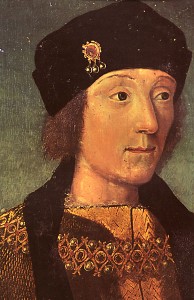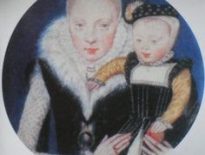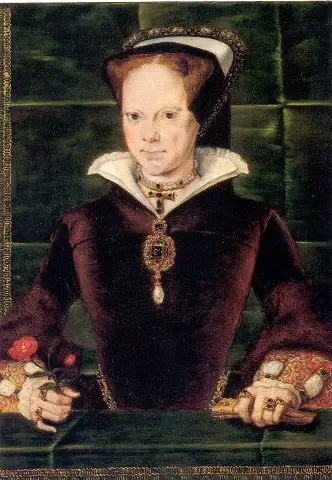 On this day in history, Sunday 7th August 1485, Henry Tudor, son of Lady Margaret Beaufort and the late Edmund Tudor, Earl of Richmond, "came unto Wales", returning from exile in Brittany to claim the throne of England from Richard III.
On this day in history, Sunday 7th August 1485, Henry Tudor, son of Lady Margaret Beaufort and the late Edmund Tudor, Earl of Richmond, "came unto Wales", returning from exile in Brittany to claim the throne of England from Richard III.
Polydore Vergil records Henry's return:
"Than Henry, thinkinge yt nedefull to make haste, that his arrive the frinds showld not be any longer kept in perplexytie betwene hope and drede, uncertane what to do, after he had made hisprayers to God that he might have an happy and prosperousjourney, he lowsyd from the mowth of Seyne with two thousand onely of armyd men and a few shippes, the calends of August, and with a soft suthren wynde. The weather being very fayre he came unto Wales the 7th day after, a lyttle before soone set, wher, entring thaven caulyd Milford, and furthwith going a land, he took
first a place the name wherof ys Dalley, wher he herd that certane companyes of his adversaryes had had ther stations the wynter by past to have kept him from landing. From thence departing in the breake of dav he went to Haverforde, which vs a towne not xne. myles from Dalley, wher he was receavyd with great goodwill of all men, and the same he dyd with suche celerytie as that he was present and spoken of all at once."
Chronicler Robert Fabyan recorded that on disembarking at Mill Bay, Henry "kneeled down upon the earth, and with meek countenance and pure devotion began this psalm: 'Judica me Deus, et discerne causam' ['Judge me, O God, and favour my cause']." He then "kissed the ground meekly and reverently, made the sign of a cross upon him" and then "he commanded such as were about him boldly in the name of God and Saint George to set forward."
Henry and his force then set off for London, marching through Wales and the Marches and gathering support on their journey. Although they were aiming for London, they actually encountered King Richard III and his forces in Leicestershire. On 22nd August 1485, the forces of Henry Tudor and King Richard III clashed at the Battle of Bosworth Field, near Market Bosworth. King Richard was killed during the battle and Henry Tudor became King Henry VII. Henry ruled until his death in April 1509 and passed the throne successfully on to his second son who became King Henry VIII.
You can find out more about Henry VII in our Henry VII e-book - click here - and also in the documentary "Winter King" - click here. I also did a Claire Chats video talk "Henry VII - Usurper?".
Notes and Sources
- ed. Ellis, Sir Henry (1844) Three Books of Polydore Vergil's English History, Comprising the Reigns of Henry VI., Edward IV., and Richard III, Camden Society, p. 216. Read online at https://books.google.es/books/about/Three_Books_of_Polydore_Vergil_s_English.html?id=Ex8IAAAAIAAJ&redir_esc=y or https://archive.org/details/threebooksofpoly29verg
- ed. Ellis, Henry (1811) The New Chronicles of England and France, in Two Parts; by Robert Fabyan, p. 672. Read online at https://books.google.es/books?id=-zk6AQAAMAAJ&pg=PR1&lpg=PR1&redir_esc=y#v=onepage&q&f=false or at https://archive.org/details/newchroniclesofe00fabyuoft
- Penn, Thomas (2011) Winter King: The Dawn of Tudor England



On this day the usurper and pretender Henry Tudor landed at Mill Bay on his quest for a lucky win at Bosworth. His claim was frail but by landing in Wales he could use family connections to help him build on his small foreign force. He could use connections via the Herberts who although remaining sensibly neutral for the main, the younger brother, Walter joined him. He had other family connections in the south and on Anglesey via his late father and grandfather and uncle, Edmund, Jasper and Owen Tudor. He could also make ancient claims to be related to Author and Uther Pendragon and Cadwallader. This is how he used his Dragon banners and standards. He also tapped into folk tales and prophetic bards. He like others before him was called a mabdragoon, a son of prophecy. He didn’t have three real dragons unlike Daenarys Targaryen in Game of Thrones so this wasn’t fantasy, but he used the old tales to good advantage. He also gained the support, probably by promising him the earth of Ryce ap Thomas, another area connection who actually made a march through Wales, recruiting as he went. A small group of Yorkist malcontents had joined him in exile and one was the veteran commander, John de Vere Earl of Oxford. He would later rely on the treason of his stepfather, married to the woman from whom his claim came, Lord Thomas Stanley and his brother, Sir William who feathered their own nests and sat the battle out until they saw an opportunity to switch sides. He didn’t have the support of the old nobility who remained with Richard, some even dying with their King. In fact had it not been for the lucky selection of a part of the battlefield being covered in marsh, Henry himself may have been killed in Richard’s charge. Richard took out Richmond’s bannerman and then unhorsed the huge Sir John Cheney and his own man, Sir William Percival had his legs cut off. However, the 200 pikemen with Henry quickly surrounded him and Richard was driven back. It was as he regrouped that his horse was lost and he was forced to fight on foot. Here Stanley saw an opportunity, charged around to come behind Richard and to flank him. In the frantic fighting that followed Richard and several of his knights and gentry were slaughtered. Norfolk had been killed in another part of the field, up by the Mill on modern Mill Lane, with Richard being killed near Fenhole, somewhere along Fen Lane.
Henry was crowned with Richard’s battle crown from his helmet, but he was not yet King. He didn’t become King automatically on Bosworth which was actually called Redefield not Bosworth, which is a later name. Part of his taking the crown now depended on the fulfilment of a vow taken a year earlier at Christmas in Vennes Cathedral to marry the eldest daughter of the House of York, Princess Elizabeth, niece of the murdered King Richard and daughter of the late King Edward iv. The claim he made to the crown was that he was the male heir to the House of Lancaster, via his mother, Margaret Beaufort. The line he came from was illegitimate and barred from the crown, even after it was made legitimate. However, Henry had won the battle so what has legitimate claims to do with anything. It was a perfectly legitimate thing to claim a throne by right of battle as lawful in the eyes of God and so the country.
Henry still had to have the acceptance of the survivors and of the noble houses, Parliament and a coronation. His promise to marry Elizabeth was quickly made known and even with legitimate alternative heirs, he moved to gain accepted and submission. Henry also pre dated his reign from the day before Bosworth making it treason to fight against him, but he showed restraint in the enforcement of this. Most soldiers were allowed home and a period set for submission. Even those like the Earl of Surrey, the son of Norfolk who had been killed, who was captured, were only imprisoned and lost lands. Surrey was pardoned and freed a few years later, some of his fortune returned to him and served the new King.
However, it wasn’t all plain sailing and many of those who had accepted Henry, including the de la Pole family, supported a pretender called Lambert Simnel who had been crowned King Edward VI in Dublin Cathedral and people thought he was either the Prince in the Tower, or another royal nephew, Edward, Earl of Warwick. An army came from the Netherlands and John De La Pole joined his cause, along with several others. Most of them were killed in a decisive victory at East Stoke in 1487. The wood be Yorkist Prince was sent to work in the Royal kitchen. Henry also had to get himself crowned and his first Parliament had another problem. His bride along with her two missing brothers, King Edward V and Prince Richard of York and her sisters had all been declared illegitimate by King Richard iii as it was shown to him evidence that their parents, Edward Iv and Elizabeth Woodville were not lawfully married. This is because of claims that Edward married another lady, Eleanor Talbot, some years before Elizabeth. The Parliament of Richard iii set out his claim on this basis and he was offered the crown by the three estates of the realm as the next legitimate male heir, not barred from the crown. The real Earl of Warwick and his sister, the future martyr, Margaret Pole, were barred because of an Act of Attainder against their father, George Duke of Clarence, killed on the orders of Edward iv for treason. Yes such an Act can be reversed, but at this time it wasn’t. Henry had the young Edward of Warwick given to his mother to care for in London, but when this happened he was moved to the Tower, not a cell, but one of several, secure but luxurious rooms. Margaret was later married of to Richard Pole and would serve Henry Viii and Katherine of Aragon for several years. After the Battle of Stoke much of the opposition to Henry was eliminated, although another pretender Perkin Warbeck would come to haunt him during the 1490s and gain support as he claimed to be Richard of York. There is still a lot of debate as to whether his claim was genuine or not. He and Warwick were executed in 1499 and he was supported by Sir William Stanley who was also executed in 1496.
Henry had to wait until January 1486 to marry Elizabeth of York as he had to reverse her illegitimate status and needed a dispensation. He also had to ensure his own authority was accepted via his own coronation. Elizabeth was not herself crowned until 1487, due to the fact she was pregnant during 1486, giving birth to Prince Arthur in September 1486 and because of the unrest. Elizabeth was a good Queen and a supportive wife and their marriage successful. He was devastated when she died aged 37 in 1503, a few days before her baby, Catherine, attempting to give him another heir to replace Arthur who had died the previous year. He never remarried and he became more remote as a ruler and a man after her death. In the end it was her second son, Henry who succeeded in 1509.